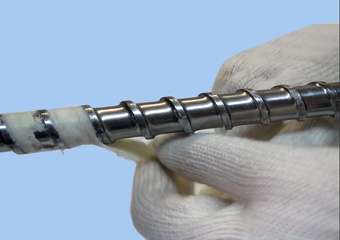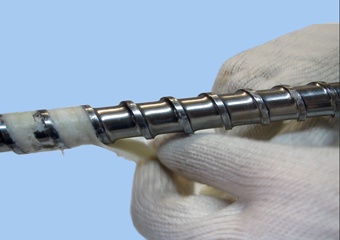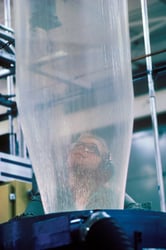
When changing from one resin to another on an injection molding machine or extrusion line, one of the issues often faced is the risk of cross contamination.
When we start making a new product with a different resin type we do not want to have any remnants of the previous resin that was being processed in the machine.
One of the ways to reduce the risk of this happening, is to simply purge the machine using a suitable purge compound. However, processors may then have concerns of residue from the purge compound, posing the risk of cross-contamination.
Although purge compounds are designed to leave much less residue, it is inevitable that there will always be some residue of a previous product left inside the machine.
There are some ways to overcome this. One method is to use a low residue purge compound.These compounds have a particularly low affinity to metal and are very easily displaced by any incoming resin behind it- one limitation on this type of compound can be the cleaning power- so low residue compounds are often used as a chaser behind a stronger scrubber. This may seem excessive, to purge out the purge, however it is extremely effective especially if you are going into a clear application, as the low residue purge compound will drastically reduce cross contamination risks AND have the added benefit of eliminating any haze.
There are however some instances, in particular when it comes to manufacturing in the medical device industry, where regulations are much more stringent when it comes to cross- contamination concerns. In these cases, when having a resin changeover in any product, it is not sufficient to just reduce the risk, but there has to be a 100% guarantee of zero contamination- the only way to do this is by manually pulling the screw.
Many manufacturers want to avoid pulling the screw due to the time constraints, manual labor and machine downtime associated with the procedure. However, in instances where it is necessary to have a 100% clean screw, the processor would have to remove the screw after every production run.
One customer of mine who manufactures implantable medical devices, could not take any risks. They were shutting down their lines after each production run to pull the screw, scrub it clean with a wire brush, and then leave the screw in oven overnight to burn off any remaining excess. This was taking several hours every evening, only for them to then go through the whole procedure again the next day. If this is your normal routine- yes it is a good way to ensure you have ZERO contamination and in this case it was a necessity-but it is extremely time consuming. Also, it means you only have very small amount of time when your production line is actually being productive.
Due to their strict regulations the customer had never considered using purge compound as an option. Even low residue grades were disregarded. However, after a review of their process I was able to recommended a “purge-assisted” screw pull to reduce the time and effort required to clean the screw AND completely eliminate cross contamination concerns.
The procedure required the purge compound to enter the barrel as per a routine purge procedure, removing as much resin as possible from the barrel. In this case we were purging the screw and barrel only so a glass-filled purge was the best grade to use.* The customer was processing at 400F, so for an easy screw removal and maximum cleaning effect, we increased melt temperature to 430F (anywhere between 430-570°F is recommended).
As soon as we saw clean purge exiting from the barrel, we extruded the remaining purge from the machine and turned off the heaters, before pulling the screw out. (NOTE: If temperature is above 460F it is recommended to wait until the temperatures in the barrel drops somewhere between 430-460°F as this is the optimum temperature at which the screw will slide out with ease, any melt temperatures outside this range will result in more effort being required to pull the screw).
In this case, the screw was removed with very little effort, and following this, remnants of the purge in the flights of the screw were simply peeled away by hand leaving behind a completely clean screw with NO residue.
I have quite often come across customers who have concerns about using a purge compound because of extremely stringent regulations that need to be followed- it is however always beneficial to look into what options are out there. This method provides a 100% guarantee of a completely clean screw, it eliminates the risks of contamination, and drastically reduces the time and effort required from what is usually a processors nightmare.
* if you are purging through the die it is recommended to use an unfilled grade for purging through the die and removing the die before going into the glass filled grade for the screw pull.
Learn about the importance of implementing proper purging procedures by downloading this free industry guide.

Kiran Raza is an Asaclean Purging Expert & Technical Sales Representative. She's worked in the plastics industry for nearly 20 years and has expertise In Bio-Medical Materials, Polymer Processing, and Materials Testing.








Comments